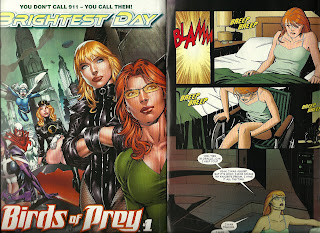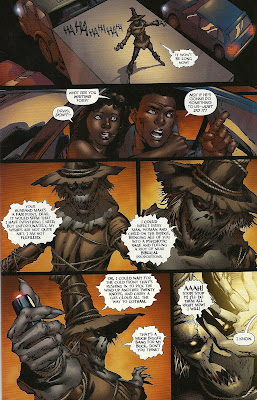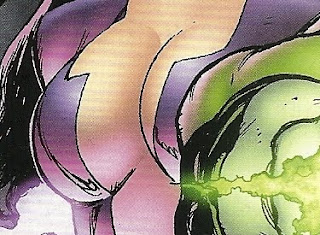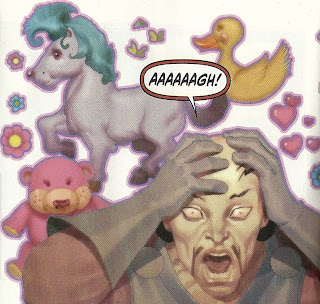
Around about the time that Bruce Wayne was dying in
Final Crisis, DC released the above teaser image to online comics-covering media outlets and then ran it is a house ad in many of their books.
The Tony Daniel image served as something of a teaser for many of the storylines to come during
Batman: Battle For The Cowl and the “Batman: Reborn” branding of the entire rejiggered Batman line. (Aside: It’s kind of interesting to look at it now, after the books it’s teasing have come and gone, and we can sort of figure out what’s being referred to in there. It looks like they held back on revealing the new Batman and Robin costumes, putting Damian in a suit and Dick Grayson in the old Batman costume, and I guess Batwoman is holding a magnifying glass because she was in
Detective Comics? Shoulda gave her a deerstalker and a pipe too…).
The element of the image I was most drawn to* was the weird half-and-half, red and black Batman costume on Two-Face standing behind the gun-toting Batman (who ended up being Jason Todd, who was only Batman for about two and a half issues of
Battle).
It’s an interesting design, in large part because it’s
so damn weird—compared to the costumes Jason Todd and Tim Drake (that’s him on the far left with the stick) sport especially. It was also rather intriguing because of the story possibilities it offered. During
52, Batman, Nightwing and Robin all took a year off to travel the world and train as a team, and Batman handpicked the then-temporarily cured Harvey Dent to fill-in for him as Gotham’s vigilante crime fighter.
Dent had since lost half his face again (for what, the fifth time? The sixth?) and became an evil archcriminal again, but perhaps when news hit that the
real Batman was dead, he would decide to fill-in for Batman again…this time permanently, and with his own costume?
That would be a Batman story I hadn’t heard yet, and when it comes to the Batman franchise, stories that haven’t already been done three or four times generally qualify as ingenious innovation.
So of all the little visual teases to be seen in the above image, the crazy-looking Two-Face-as-Batman one I was most interested in seeing play out.
Where did it play out? In
Batman #688-#691, the last four issues of writer Judd Winick’s aborted second run on the title, for which he was paired with pencil artist Mark Bagley, fresh off his run on weekly comic
Trinity.
Unfortunately, it’s not much of a role. Here is every single appearance of the Two-Face Batman from those comics, starting with Daniel’s cover for #691 and then proceeding to panels from Bagley and inker Rob Hunter’s interiors from #690 and #691 (So, um,
SPOILER ALERT):


That’s the big reveal of a mysterious villain from early in the arc, a last page splash-page from #690 (Note the comically large darts in Batman’s shoulders).

That’s the Two-Face Batman from the title page of #691.

And that’s the next page of the same book, in which Dick Grayson realizes he’s hallucinating because he was just shot up with some gigantic drug-filled darts, and he’s really just been getting punched around by Two-Face in a pair of Bat-gauntlets.
So that neat-o Bat-costume? The idea of Two-Face running around as a Batman replacement of some kind? There was absolutely nothing to it. The costume was apparently designed for no more than a three or four page drug-induced dream sequence.
That seems like a bit of a waste, doesn’t it? In fact, it made me wonder if perhaps it initially was part of some story arc that never came to be, because, if not, it’s pretty strange that it was given that much space in the “I Am Batman” teaser image promotion thingee, if there was nothing more to it than a few panels of Dick Grayson imagining it.
As for the story that the comics actually
do contain, it’s called “Long Shadows” and, like
the previous Winick-written issue of Batman, it’s actually pretty good—particularly on the Judd Winick-written DC super-comic scale.
It opens with some unseen figure knocking current Batman Dick Grayson around the Batcave saying things like, “
Batman’s dead. So
what does that make
you?!” while doing so.
We then flash back a couple of weeks to the beginning of Grayson’s career as Batman, and, over the course of three issues, work our way back to that opening scene (Which I spoiled by positng about Two-Face’s Batman costume above).
This is another surprisingly character-focused issue by Winick, and the story is split between two main subjects: The differences in the way that Dick Grayson and Bruce Wayne approached Batmanhood, and a conflict between Two-Face and Grayson.
As Batman, Grayson smiles…a lot. Like, a Bob Haney-written Batman a lot. He also allows himself to be photographed and recorded, and works harder to leave evidence for the police, making convictions easier. He’s a kinder, gentler Batman, something which the world at large notices and remarks upon, but only Two-Face seems to realize that means a different person is playing the role of Batman.
Meanwhile, The Penguin, Two-Face and Black Mask II are all jockeying for position in Gotham’s underworld, and Two-Face sics Batman on Penguin, all the while trying to figure out what all the little changes he’s noticing can mean, before he ultimately finds a way into the Batcave to ambush Dick Grayson.
Winick writes the main players fairly well—for the most part, they all sound and behave like themselves, which, for this kind of comic, really accounts for about 75% of whether or not the scripts are “good” or not. The focus on things like how Dick and Bruce fight differently, and how Dick gets along with a Robin and a sarcastic British butler differently are welcome, giving
Batman a different focus than Grant Morrison’s
Batman and Robin.
Winick’s still showing some of his personal ticks, however. Two-Face and The Penguin are both completely interchangeable characters here; either of them could play either’s role just as well, and, as presented here, there’s no reason that it couldn’t have been The Penguin who figured out that the Batmen had changed and tried to use that to his advantage (Except for the fact that Daniel or whoever had already designed a Two-Face Batman costume…although I bet a fat little Batman in a top hat would have looked fairly cool too).
Winick writes the bulk of the Two-Face scenes like the bulk of all his villain scenes—The Penguin, Lex Luthor, Dr. Sivana, Brick—with the bad guy explaining his plans to an underling at great, expositionary length).
There were also a couple of things that felt a bit off. The first was the inclusion of some more superheroic elements. Two-Face’s plan to get at Batman is to hire a metahuman with a very specific teleporting power to teleport him inside the Batcave, by somehow touching a Batarang and then teleporting to the location it was made in.
Obviously Batman is a superhero, and superpowers are well within his milieu, but, in general, Batman seems to appear in comics with superpowers more than superpowers appear in Batman comics. Two-Face trying to hire Titans/Doom Patrol villain Warp, for example, or coming up with a plan that involves teleportation at all seems like more of a pre-Crisis Batman story than a post-Crisis one to me. I understand
why Winick did it, since he wanted to get Two-Face into the Bat-cave without actually knowing the Bat-cave’s location or figuring out that Bruce Wayne was Batman, but it seems like more a
Superman/Batman or
The Brave and The Bold storyline to me, rather than a
Batman one, if that makes sense.
The other odd thing is that Grayson is eventually able to convince Two-Face that he is indeed the same Batman Two-Face has
always fought, he’s simply started acting a little different, changed gloves and got a new belt.
Two-Face seems to get convinced awfully quickly after having spent the bulk of the story researching the differences between the two Batmen–he changes his mind in the course of a single fight scene—and given that he’s been fighting Dick Grayson as Robin and/or Nightwing for, I don’t know, a
decade or so, he should know him pretty well by now.
Some of Batman’s longest-lived foes, like The Joker and Two-Face, have often been shown as knowing that Batman’s Robins have changed over the years, and that Nightwing was the first Robin, so one would think an old hand like Two-Face would be a little more on the ball here.
It’s been a while since I read
Prodigal, the storyline about Dick Grayson temporarily becoming Batman from the nineties, but I seem to recall Two-Face being one of the major villains in it, and Two-Face figuring fairly prominently in some Robin: Year One-era stories written around that time.
And then there’s the fact that Two-Face
just had a big, personal, intense conflict with Dick Grayson in
Nightwing’s “Batman: RIP” tie-in arc, which, coincidentally enough,
also involved Dick Grayson in a fight while suffering drug-induced hallucinations.
The artwork is perhaps the best I’ve seen from Bagley since he left Marvel and
Ultimate Spider-Man for DC. I’m not entirely sure what to attribute the strength of his work here to, but it may simply be that he had no reason to rush, as he was drawing on a 22-pages-per-month schedule, instead of the 40ish-per-month schedule of
Trinity or the 30-pages-per-month schedule of
JLoA.
His artwork clearly reflects Winick’s story about Batman being a different Batman, and his Dick Grayson-as-Batman is often smiling and almost always airborne. It’s clear that there’s a different person under the costume, and given that Bagley’s art has never been super-exact when it comes to individualizing characters by their facial features or body structure, that’s a testament to his communicative ability.
Also, it’s just plain hella dynamic work. Check out this page of Batman fighting:

He shoots himself like a missile at those crooks.
Unfortunately for Winick and, I suppose, the
Batman readers at the time, his run on the book would be cut short—presumably because
he dared speak out of turn about behind-the-scenes goings-on in the Bat-office—and this marked the end of his run.
His leaving the book
must have been rather sudden and unexpected, as he was clearly building up conflicts for future storylines. One was Black Mask II’s presence, as the mysterious new legacy villain played Penguin and Two-Face off of one another, and, by the end of the story, had managed to get The Penguin to serve under him and to exile Two-Face from Gotham.
The next writer, Tony Daniel, would pick up on
that plotline in
his run, but not on the one Winick introduced at the very end of the book, in which Grayson finds a hidden flash drive in the Batcave and discovers that his mentor was secretly investigating the murder of The Graysons, and was apparently hiding some details from Dick.
What exactly was the original Batman hiding? That’s what Dick asks aloud at the end of the last issue of Winick’s run, and we never do find out.
Oh well. The important thing is that Winick was apparently punished for telling
Comic Book Resources that he was originally writing
Battle for the Cowl, not how good the actual comic books are, right?
*
After this element, of course.********************
Next: Tony S. Daniel and Sandu Florea's Batman #692-#696
 1.) Once upon a time, a "#1" on the cover of a comic book was seen as a deterrent rather than an enticement to buying a comic book. Jetta was only published for three issues, but those issues were numbered #5, #6 and #7. Why was that?
1.) Once upon a time, a "#1" on the cover of a comic book was seen as a deterrent rather than an enticement to buying a comic book. Jetta was only published for three issues, but those issues were numbered #5, #6 and #7. Why was that? 2.) Betty Cooper cosplays as Black Canary. As you can see from the above image, a piece of original art DeCarlo drew for Will King. That's actually only half of the image, which is spread across two pages of Dan DeCarlo's Jetta, but I could only fit half of it on my scanner. DeCarlo drew Betty in Black Canary's original costume, so the other half has her high-heeled black boots with the pirate-y cuff, with DeCarlo's signature beneath it.
2.) Betty Cooper cosplays as Black Canary. As you can see from the above image, a piece of original art DeCarlo drew for Will King. That's actually only half of the image, which is spread across two pages of Dan DeCarlo's Jetta, but I could only fit half of it on my scanner. DeCarlo drew Betty in Black Canary's original costume, so the other half has her high-heeled black boots with the pirate-y cuff, with DeCarlo's signature beneath it. 
 3.) Before Willie Lumpkin had The Baxter Building on his route, he starred in his own comic strip. Yoe includes a page of four comic strips in his introduction to the book. The first three are try-out strips form a newspaper syndicate, and the fourth one is the one above (which I've cut from it's four-panel horizontal strip format to make it fit better on a vertical blog like this). It's called Willie Lumpkin, and was published through Publishers Syndicate around 1960 or so. Look how young Willie was! (You can see a few more examples of the strip here).
3.) Before Willie Lumpkin had The Baxter Building on his route, he starred in his own comic strip. Yoe includes a page of four comic strips in his introduction to the book. The first three are try-out strips form a newspaper syndicate, and the fourth one is the one above (which I've cut from it's four-panel horizontal strip format to make it fit better on a vertical blog like this). It's called Willie Lumpkin, and was published through Publishers Syndicate around 1960 or so. Look how young Willie was! (You can see a few more examples of the strip here).

















































